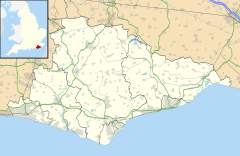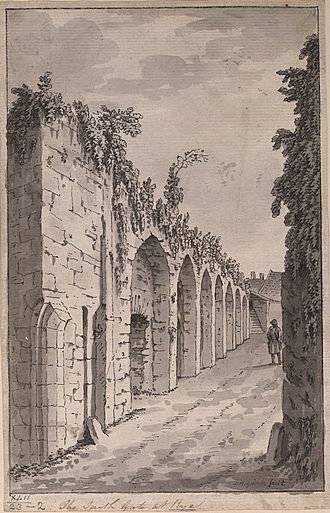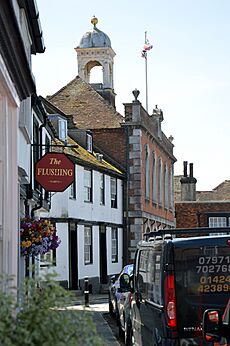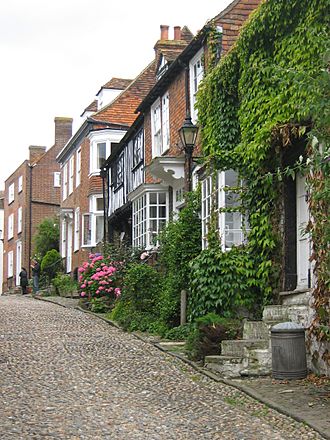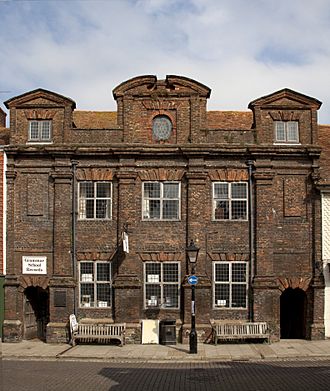Rye, East Sussex facts for kids
Quick facts for kids Rye |
|
|---|---|
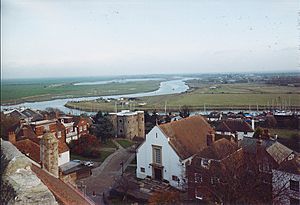 The Ypres tower, Rother, Rye Harbour and marshes seen from the tower of St Mary's Church, Rye |
|
| Area | 4.2 km2 (1.6 sq mi) |
| Population | 9,041 (Parish-2012) |
| • Density | 2,810/sq mi (1,080/km2) |
| OS grid reference | TQ920206 |
| • London | 53 miles (85 km) NW |
| Civil parish |
|
| District |
|
| Shire county | |
| Region | |
| Country | England |
| Sovereign state | United Kingdom |
| Post town | RYE |
| Postcode district | TN31 |
| Dialling code | 01797 |
| Police | Sussex |
| Fire | East Sussex |
| Ambulance | South East Coast |
| EU Parliament | South East England |
| UK Parliament | |
| Website | Town Council |
Rye is a historic town and civil parish in East Sussex, England. It is about 3 kilometers (2 miles) from the sea, where three rivers meet: the Rother, the Tillingham, and the Brede. In the Middle Ages, Rye was an important member of the Cinque Ports, a group of coastal towns that helped protect England. Back then, it was almost completely surrounded by the sea.
In 2011, Rye had a population of 4,773 people. Because it was so close to the sea, Rye played a big role in naval history, providing ships for the King during wars. It was also known for secret activities like smuggling. Famous old inns like The Mermaid Inn and The Olde Bell Inn are said to have secret tunnels connecting them, which were used by groups like the Hawkhurst Gang.
Today, Rye's rich history and charming streets make it a popular place for tourists. You can find many hotels, guest houses, and restaurants here. Rye still has a small fishing fleet, and Rye Harbour offers places for yachts and other boats to dock.
Contents
- A Look Back: Rye's History
- Rye's Royal Connections
- How Rye is Governed
- Rye's Location and Landscape
- Rye's Economy and Activities
- Getting Around Rye
- Learning in Rye
- Places to Worship
- Things to Do and See
- Famous People Connected to Rye
- Rye in Books and Movies
- Rye and Art
- Twin Town
- Sports in Rye
- See also
A Look Back: Rye's History
The name Rye might come from an old word, rie, which means "a bank." Old maps show that Rye was once on a large bay of the English Channel. This bay was a safe place for ships to anchor. Even in Roman times, Rye was important for shipping and storing iron from the Wealden Iron Industry. The famous Mermaid Inn has been around since 1156!
Rye was once owned by a French abbey until 1247. By 1189, Rye became a "limb" (a supporting town) of the Cinque Ports and later a full member. Being part of this group was very important for protecting the town and its trade. One of Rye's oldest buildings is Ypres Tower. It was built in 1249 to defend the town from the French and is now part of the Rye Museum.
In 1289, King Edward I gave Rye its own special charter. This meant the town got privileges and didn't have to pay certain taxes, in exchange for providing ships for the King. The "Landgate," built in 1329, is the only remaining fortified entrance to Rye. It's still the only way for vehicles to enter the old part of town, but only small vehicles can fit!
Changes to the Coastline
The River Rother used to flow east into the sea near New Romney. But in the 13th century, huge storms (especially in 1250 and 1287) changed the river's path and cut Rye off from the sea. These storms also destroyed Old Winchelsea. By 1375, the sea and river together destroyed the eastern part of Rye. Ships then started using the current area, called the Strand, to unload goods. Two years later, the French attacked and burned the town. Because of this, the town walls were ordered to be finished to protect against invaders.
Rye was considered one of the best Cinque Ports, but people had to work constantly to stop the river and harbor from filling up with mud. As ships became bigger and needed deeper ports, Rye's economy started to slow down. Fishing and smuggling became more important. People had been smuggling goods since 1301 to avoid taxes. By the late 1600s, it was very common in Kent and Sussex.
Lifeboats and Wars
Since 1803, lifeboats have been stationed at Rye. The lifeboat station is now at Rye Harbour, about 3 kilometers (2 miles) downriver. A sad event happened in 1928 when the Mary Stanford Lifeboat sank, and everyone on board was lost. There are memorials in Winchelsea and at Rye Harbour Church, and a folk song tells the story.
During the Napoleonic Wars (1803–1805), Rye was seen as a likely place for a French invasion. The Royal Military Canal was planned from Pett Level to Hythe as a defense. However, it was finished long after it was needed.
From 1838 to 1889, Rye had its own small police force. They often had trouble on Bonfire Night (November 5th) because of bonfire gangs. In May 1940, during World War II, the Rye fishing fleet was asked to help rescue British soldiers from Dunkirk, but they did not go.
Rye's Royal Connections
Rye has always had strong ties to the British royal family. This is because it was part of the Cinque Ports and a key defense point on the coast. King Edward III and the Black Prince defeated the Spanish in Rye Bay in 1350. Later, Queen Elizabeth I visited in 1573 and gave the town the right to be called "Rye Royal." King Charles I once called Rye "The cheapest sea-towne for the provision of fish for our house." In 1726, King George I stayed in Rye for four days at Lamb House after his ship got stuck on Camber Sands.
How Rye is Governed
Historically, Rye was an independent town with its own Mayor of Rye and magistrates. These special powers ended in 1972. Today, Rye has a Town Council, which is like a local government for the town. The Council has 16 members, and one of them is chosen as the Mayor of Rye. At Rye Town Hall, you can see a list of mayors going all the way back to the 13th century!
Most local government tasks are handled by the Rother District Council and the East Sussex County Council. Rye is also part of the parliamentary constituency of Hastings and Rye. This means people in Rye vote for a Member of Parliament to represent them in the UK government.
Rye's Location and Landscape
Rye is located where the high land of the Weald meets the coast. In medieval times, the large bay allowed ships to reach the port easily. Over centuries, storms and land reclamation caused gravel to build up, blocking the port. The River Rother also changed its path. Now, Rye sits where the Rother meets the River Tillingham and the River Brede, and the Rother flows south into Rye Bay.
A small part of Rye, called the Citadel, is on the original high ground. This area has historic buildings like St Mary's parish church, Ypres Tower, and many old houses on Mermaid Street and Watchbell Street. Most of Rye's residents live outside this old Citadel area.
Rye's Economy and Activities
Over the years, Rye has been a trading port, a naval base, a fishing port, and a market town. The old part of town has many shops, art galleries, and restaurants. Rye is also known for its oast houses in nearby villages. These old buildings, once used for drying hops, have often been turned into homes or inns.
Rye's beauty makes it a popular tourist spot. Its "perfect cobbled lanes, like Mermaid Street," are often photographed. Nearby, Camber Sands beach offers "moody sand dunes and a long sandy beach." The area is also known as "1066 country" because of its historical importance. In 2016, an estimated one million people visited Rye.
Since World War II, Rye has become a center for ceramics. The town also continues to be a working port. At Rye Harbour, Rastrums Wharf can handle large ships. Rye fishing boats, marked with "RX," bring in fresh fish daily. Some fish is sold at the quayside, but most goes to a large market in Boulogne, France.
Rye is also an important place for yachting. It's one of the only safe harbors for many miles along this part of the Channel coast. Yachts can moor at Rye Harbour or Strand Quay.
Fun Events and Local Media
Rye hosts an annual two-week Arts Festival every September, featuring music, comedy, and literature.
On the second Saturday after November 5th, the "Bonfire Boys" put on the annual Rye Bonfire event. This includes a torch-lit parade through the streets, a huge bonfire where a chosen "effigy" is burned, and a spectacular firework display. This event attracts over 10,000 visitors!
For local news, Rye has BBC South East and ITV Meridian on TV. Local radio stations include BBC Radio Sussex and Cinque Ports Radio. The town's local newspaper is Rye News.
Getting Around Rye
In the late 1700s, Rye was connected to a system of main roads. These roads are now the A268 and the A259. Buses connect Rye to other towns and villages like Tenterden, Hastings, and Tunbridge Wells.
Rye railway station is on the Marshlink line, which runs between Hastings and Ashford. You can catch a train to London St Pancras from Ashford.
Before World War II, a summer steamship service ran from Rye to Boulogne, France. There was also a tramway, the Rye & Camber Tramway, which served golf courses and Camber Sands. It closed during the war and never reopened.
Many long-distance walking paths pass through Rye. These include the Saxon Shore Way, the 1066 Country Walk, the High Weald Landscape Trail, and the Royal Military Canal Path.
Learning in Rye
Rye College is the secondary school in Rye. The town's primary schools, Tilling Green Infant School and Freda Gardham Community School, were replaced by a new school, Rye Primary, in 2008.
Places to Worship
Rye has several places of worship. St Mary's, the Anglican parish church, has Norman origins. There is also St Anthony of Padua Roman Catholic church, a Baptist chapel, and former Congregational, Independent, and Methodist churches.
Things to Do and See
Rye is a local hub for the Romney Marsh and Walland Marsh areas, as well as a popular tourist spot. The Rye Farmers' Market takes place every Thursday morning on Strand Quay. Rye is well-known for its shops selling antiques, old books, and records. It also has many art galleries showing works by local artists.
Rye Castle Museum has two locations: on East Street and at the Ypres Castle. Rye Art Gallery, established in the 1960s, focuses on modern art and also displays historical artworks.
Rye is surrounded by important nature reserves. The Rye Harbour SSSI (Site of Special Scientific Interest) is to the south and includes the Rye Harbour Nature Reserve. Other nearby reserves include Pett Levels and Pools, Pannel Valley, Scotney Lake, and the RSPB reserve at Dungeness.
The Rye wharf has been updated for the RX fishing fleet, providing modern facilities for handling fish. Rye is also becoming known as a food destination, using fresh local seafood. The annual "Rye Bay Scallop Festival" in February celebrates local seafood.
Famous People Connected to Rye
Many famous writers and artists have lived in or visited Rye.
- Conrad Aiken (1889–1973), an American writer, lived in Jeake's House.
- Joan Aiken (1924–2004), a children's author, was Conrad Aiken's daughter.
- Edward Burra (1905–1976), a painter, was born near Rye and lived in the town.
- John Christopher (1922–2012), a science fiction author. The TV series The Tripods was filmed near his house.
- Tom Chaplin (born 1979), the singer from the band Keane.
- Monica Edwards (1912–1998), a children's author who set her Romney Marsh novels in the area, calling Rye "Dunsford."
- Henry James (1843–1916), a famous American author, lived at Lamb House.
- Paul McCartney, from The Beatles, has a home near Peasmarsh.
- Spike Milligan (1918–2002), a comedian and writer, was vice-president of the Rye Rugby Club.
- John Ryan (1921–2009), the creator of Captain Pugwash, lived in Rye.
- Malcolm Saville (1901–1982), a children's author, set many of his Lone Pine adventure books in Rye, including The Gay Dolphin Adventure and Rye Royal.
- Russell Thorndike (1885–1972) wrote his Dr Syn novels about smuggling on the marshes.
- J. M. W. Turner (1775–1851), a famous painter, created many drawings and paintings of Rye and its coastline.
Rye in Books and Movies
Many travel writers have described Rye over the centuries. Daniel Defoe wished that Rye's harbor could be restored to its former glory.
Rye has inspired many writers. Lamb House, now owned by the National Trust, was home to Henry James and E. F. Benson. Other writers like Joseph Conrad, Ford Madox Ford, and Stephen Crane also lived nearby. H. G. Wells and Virginia Woolf visited Rye.
Lamb House and Rye are important settings in Benson's Mapp and Lucia novels, where they are called Mallards House and Tilling. Both a 1980s and a 2014 BBC TV show based on these novels were filmed in Rye.
Rye and Art
The town and its beautiful surroundings have often been painted by artists. Many of their works are shown in Rye's art gallery. An early painting from the 1600s, showing Rye as an island port, is in the Rye Castle Museum. Later artists like Thomas Girtin, William Daniell, and J. M. W. Turner also painted views of the town. In the 20th century, the harbor and marshes attracted artists such as Paul Nash, Eric Ravilious, and John Piper. Edward Burra also lived near Rye and often painted its landscapes and people.
Twin Town
Rye is twinned with Rye, New Hampshire, in the United States.
Sports in Rye
Rye has a non-League football club called Rye Town FC. They play their home matches at The Salts. Rye also has a rugby union club, Rye RFC, which was formed in 1991 and has both adult and youth teams.
See also
 In Spanish: Rye (Sussex Oriental) para niños
In Spanish: Rye (Sussex Oriental) para niños


